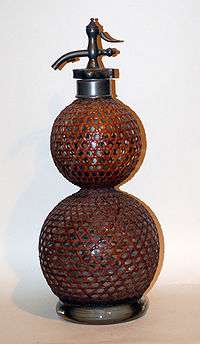Gasogene

The gasogene (or gazogene or seltzogene) is a late Victorian device for producing carbonated water. It consists of two linked glass globes: the lower contained water or other drink to be made sparkling, the upper a mixture of tartaric acid and sodium bicarbonate that reacts to produce carbon dioxide. The produced gas pushes the liquid in the lower container up a tube and out of the device. The globes are surrounded by a wicker or wire protective mesh, as they have a tendency to explode.[1]
The earliest occurrence of the word noted in the Oxford English Dictionary dates from 1853, quoting a reference in Practical Mechanic's Journal on "Gaillard and Dubois' 'Gazogene' or Aerated Water apparatus".[2] A gasogene is mentioned as a residential fixture at 221B Baker Street in Arthur Conan Doyle's Sherlock Holmes story "A Scandal in Bohemia": "With hardly a word spoken, but with a kindly eye, he waved me to an armchair, threw across his case of cigars, and indicated a spirit case and a gasogene in the corner." One is also mentioned in "The Adventure of the Mazarin Stone". The device plays a key role in Bernard Shaw's 1905 comic play Passion, Poison, and Petrifaction, Or The Fatal Gazogene.[3]
The word is also used in Douglas Preston and Lincoln Child's novel Brimstone, published in 2005, on page 106.[4]
See also
Notes
- ↑ Mixing it up: A Look at the Evolution of the Siphon-Bottle
- ↑ "gazogene", Oxford English Dictionary (subscription required).
- ↑ Shaw, pp. 1113–19
- ↑ Preston, Douglas; Child, Lincoln (2005). Brimstone. New York: Warner Vision Books. p. 106. ISBN 9780446612753.